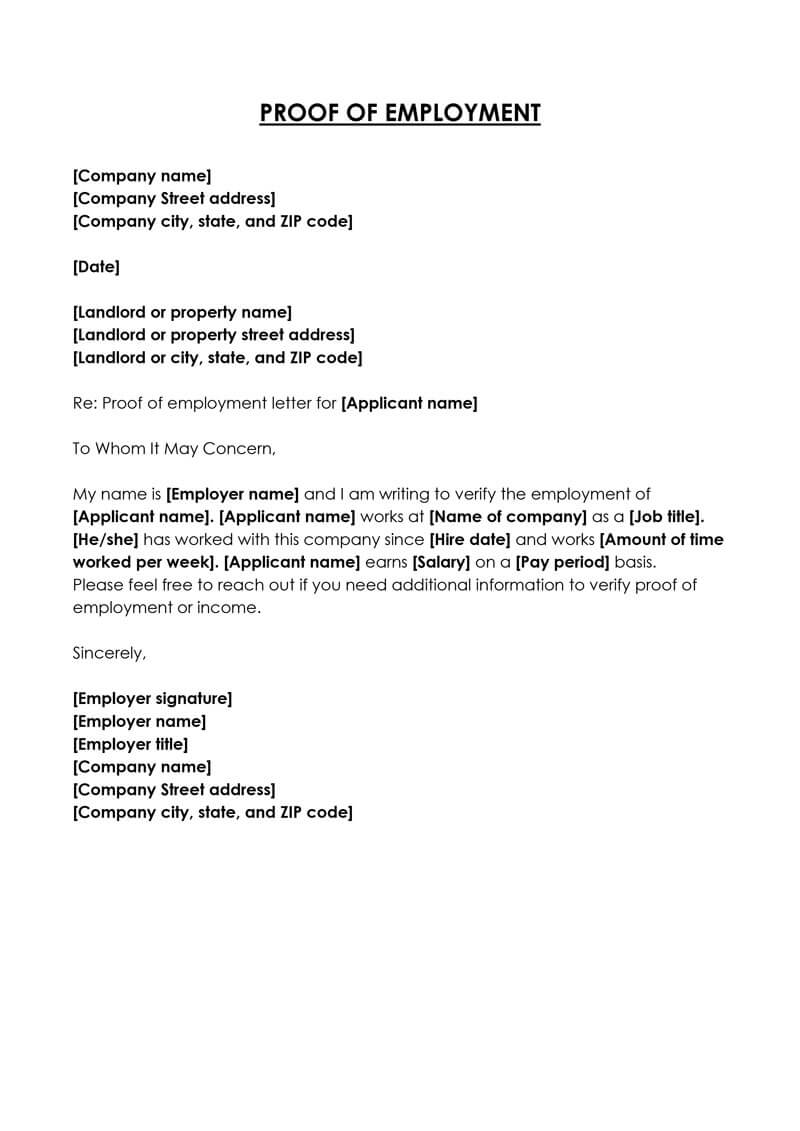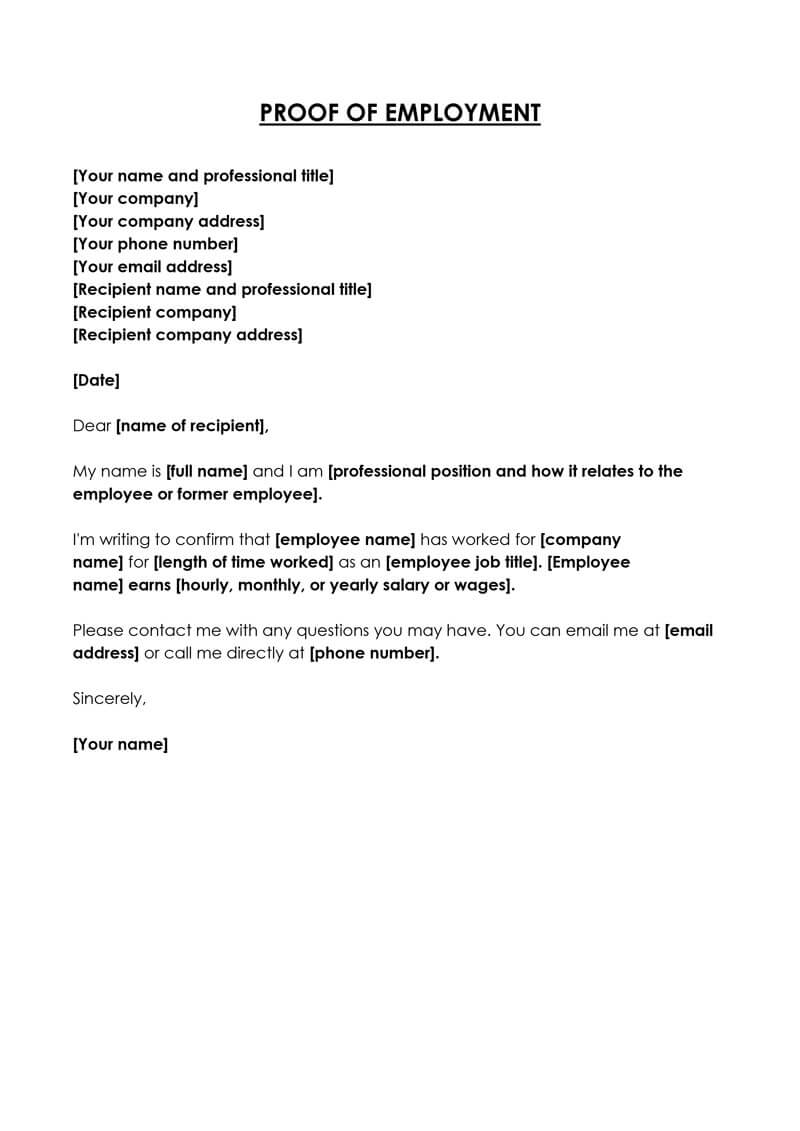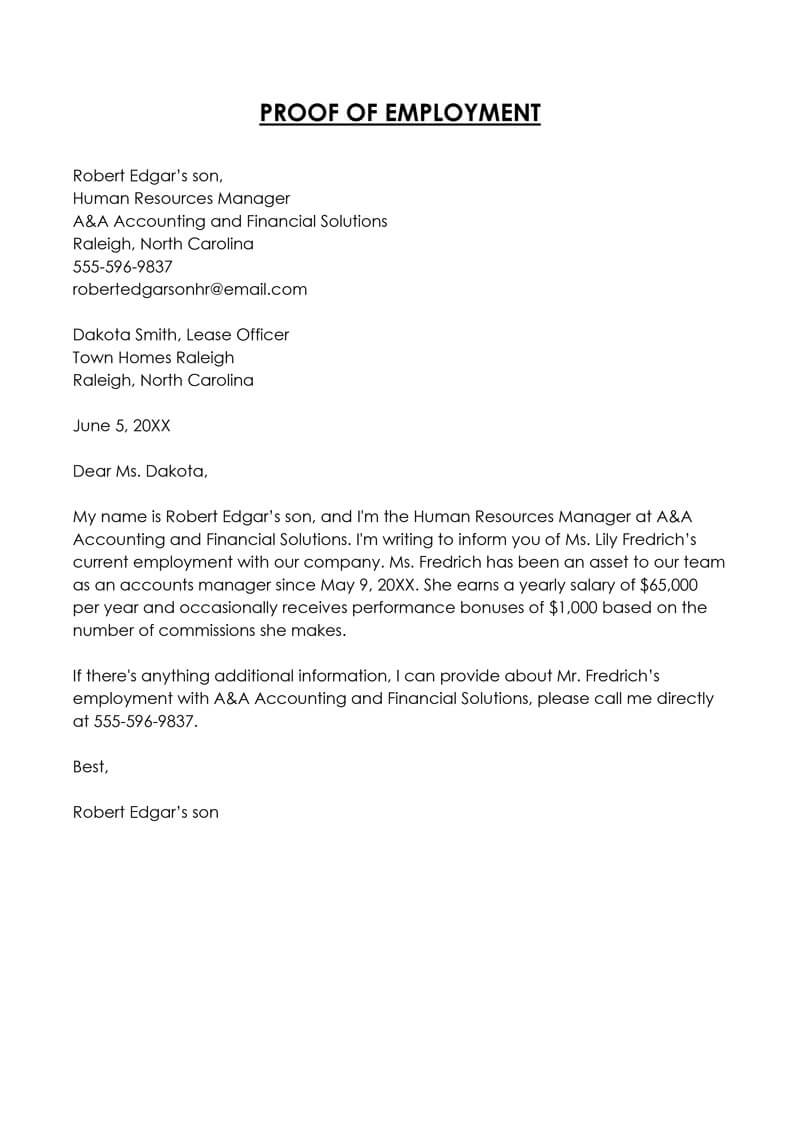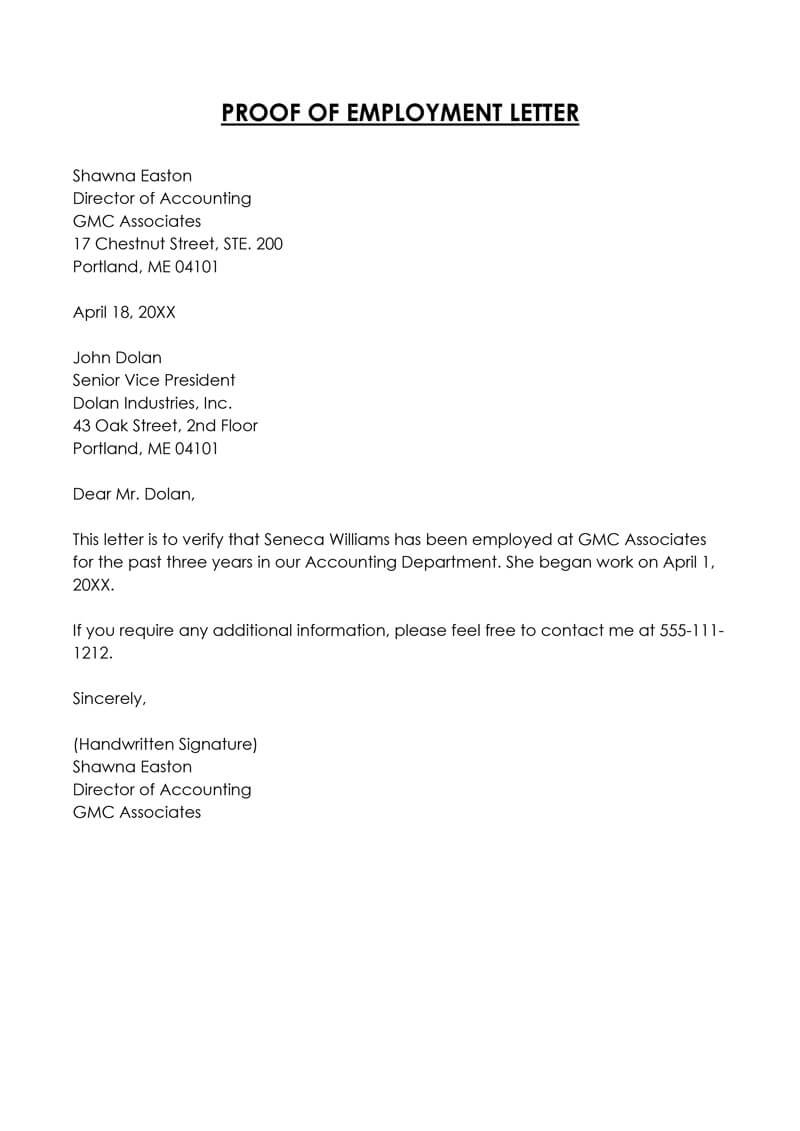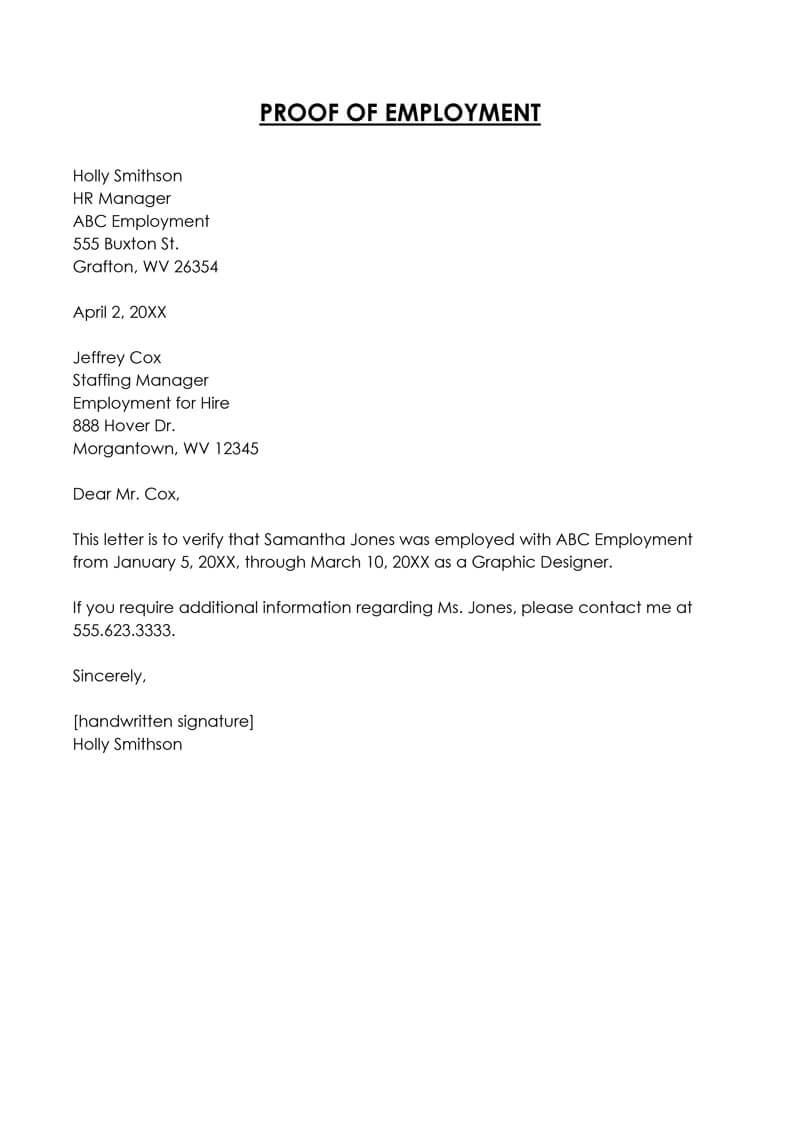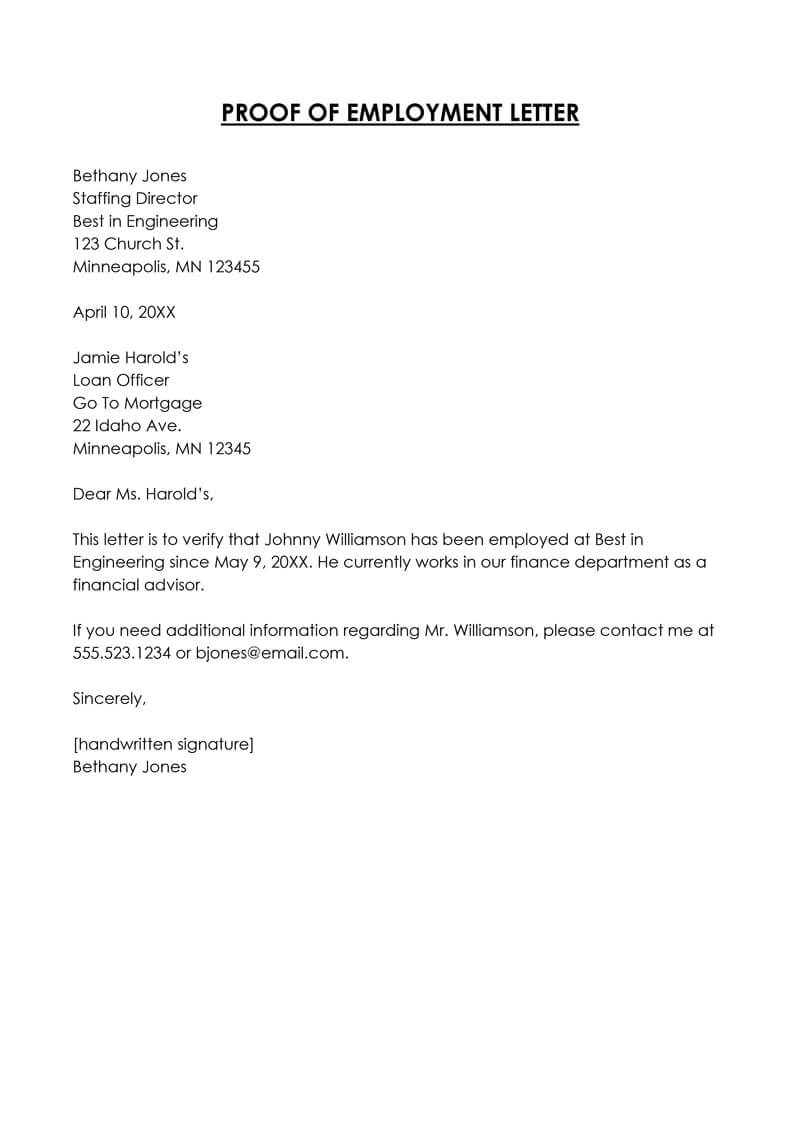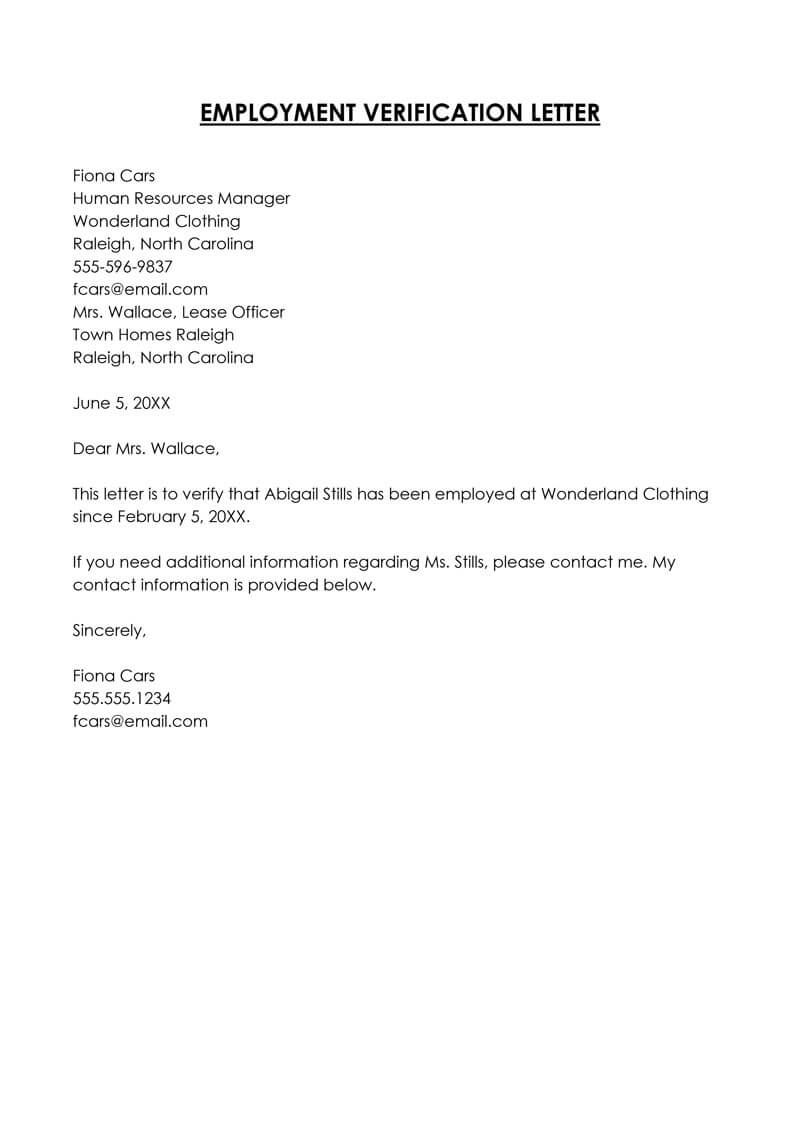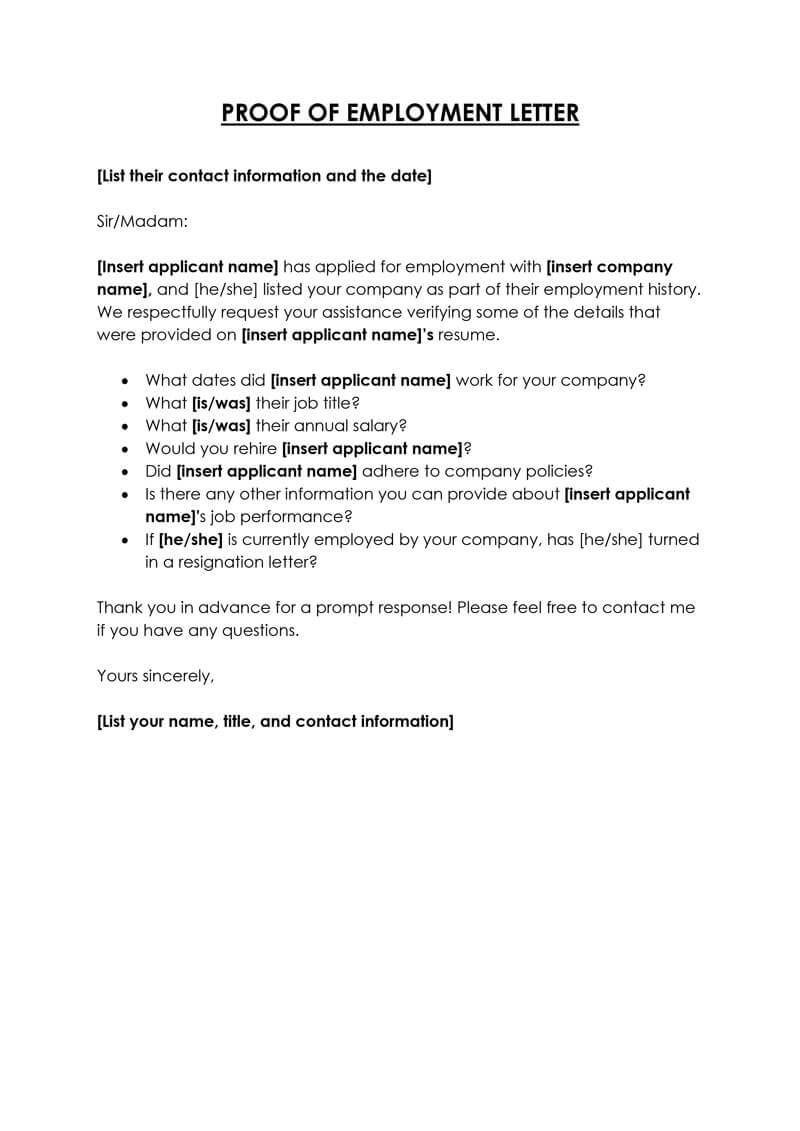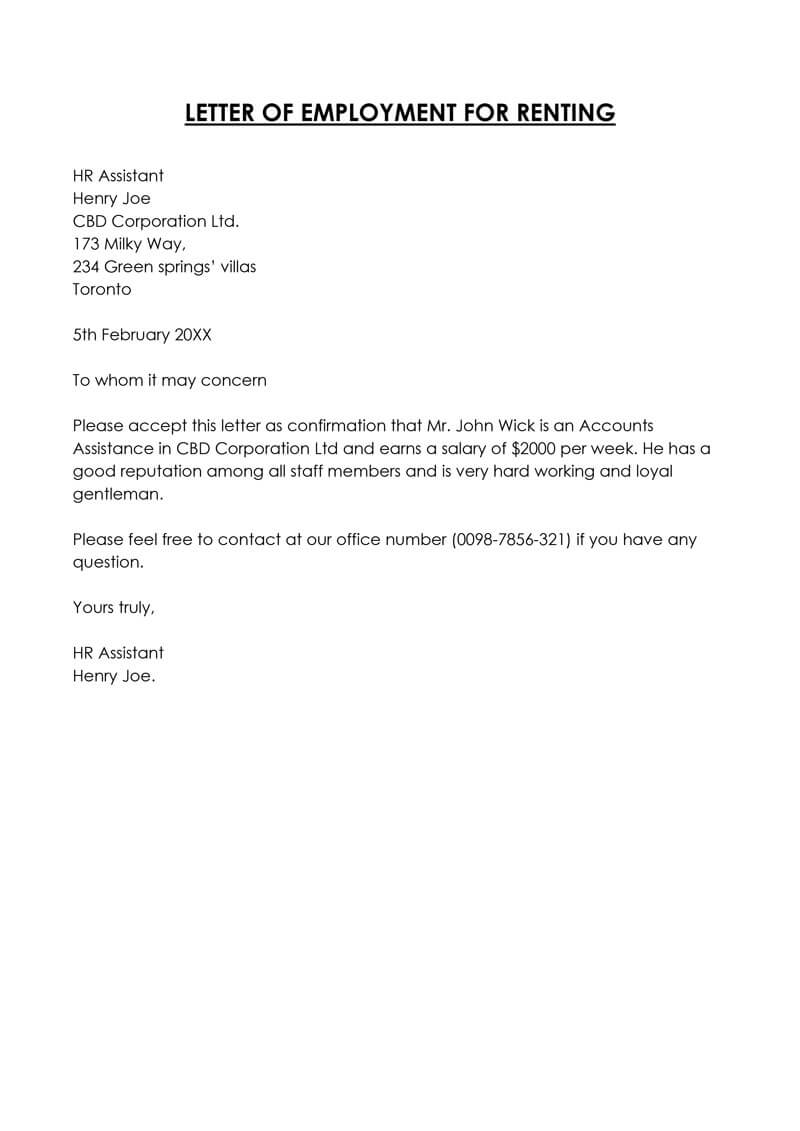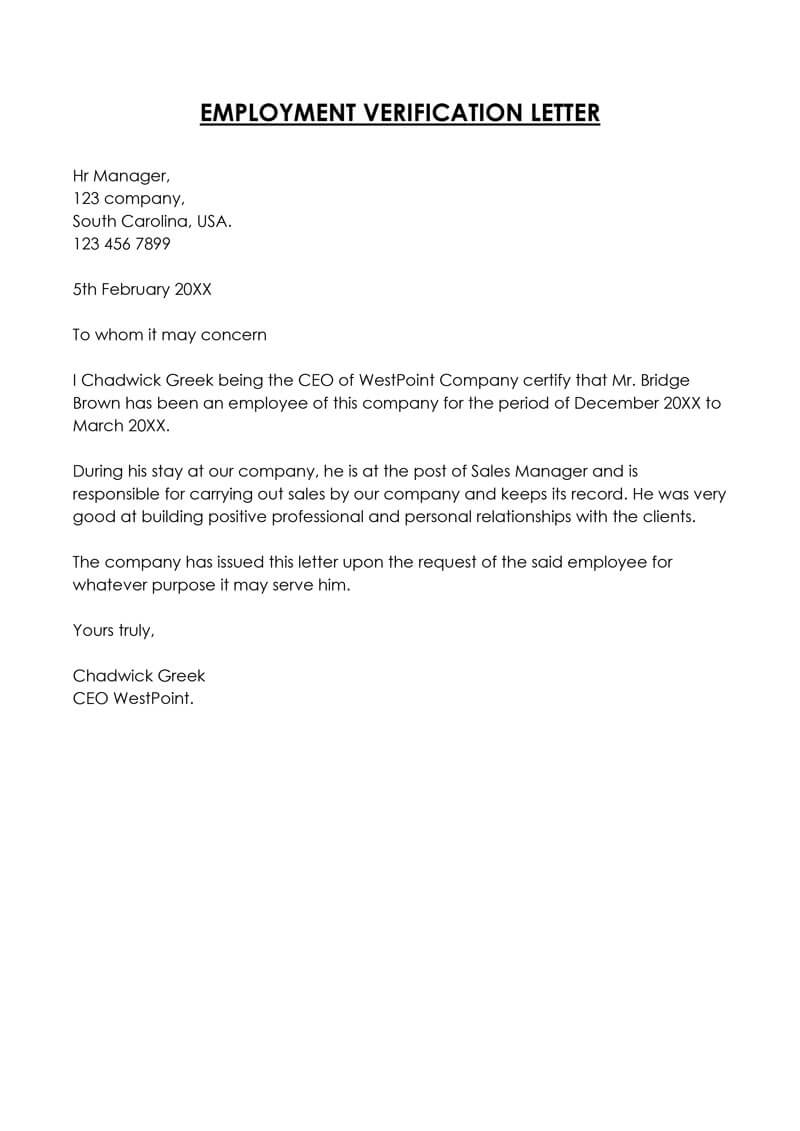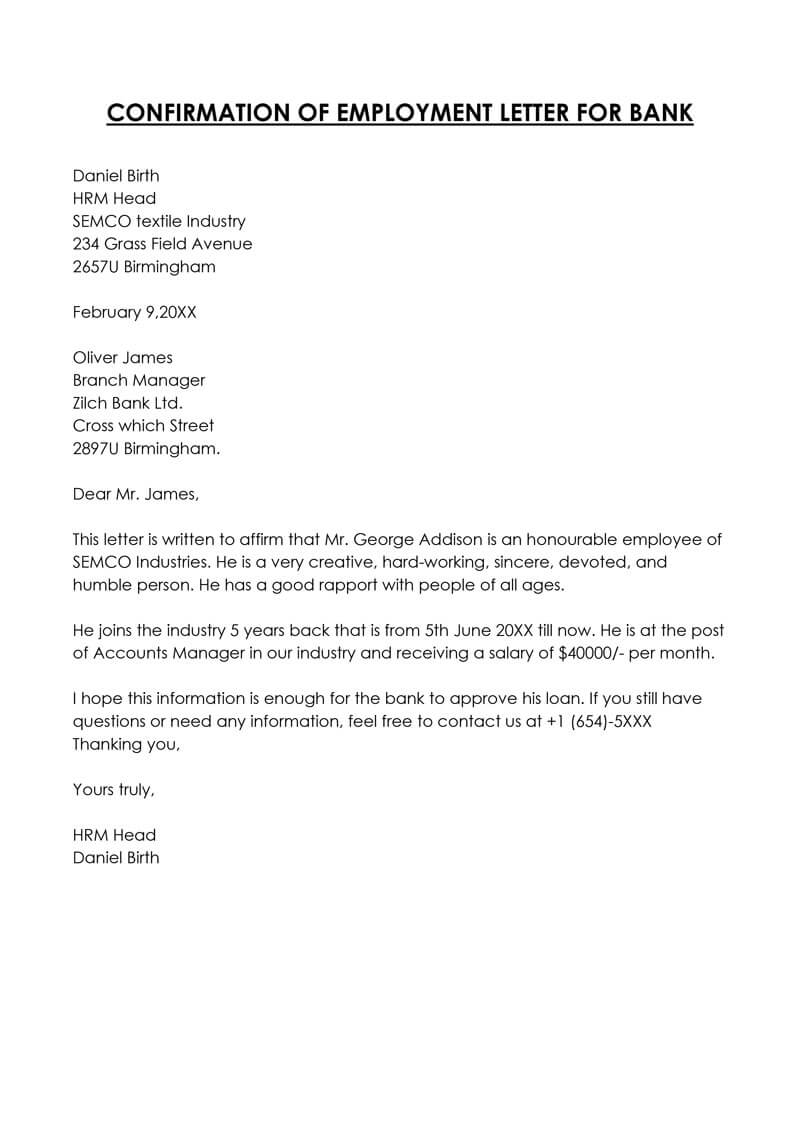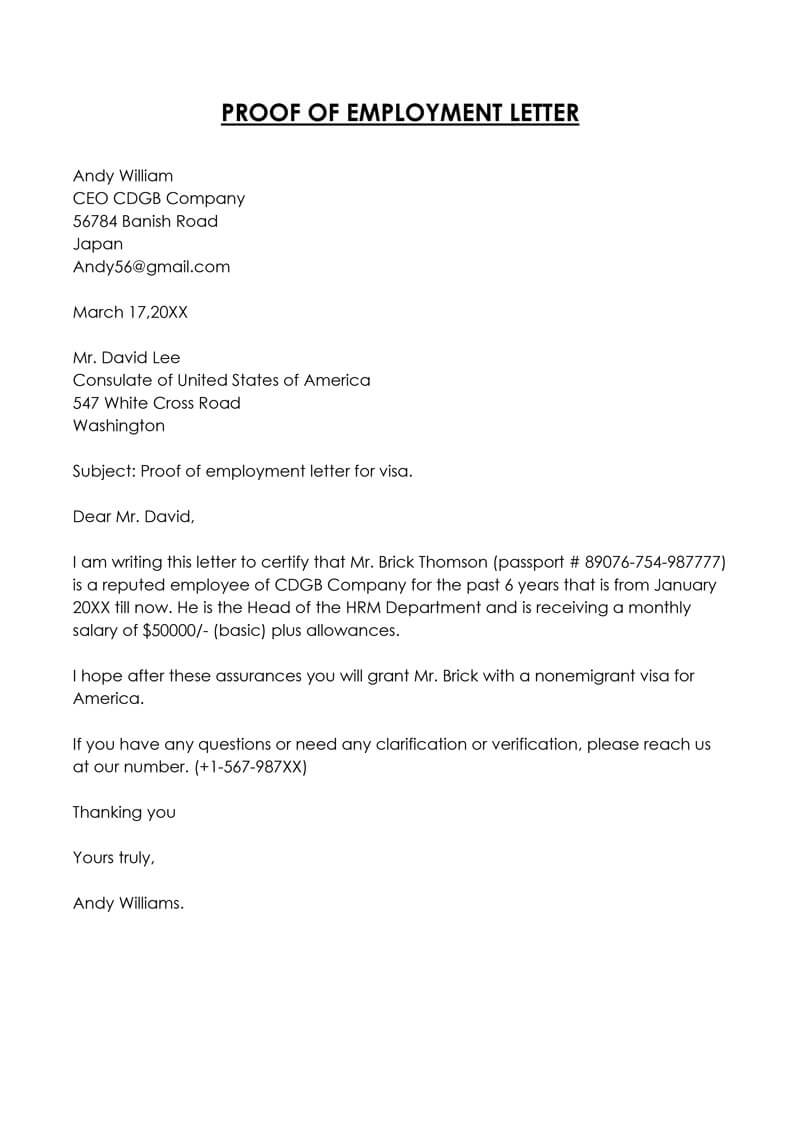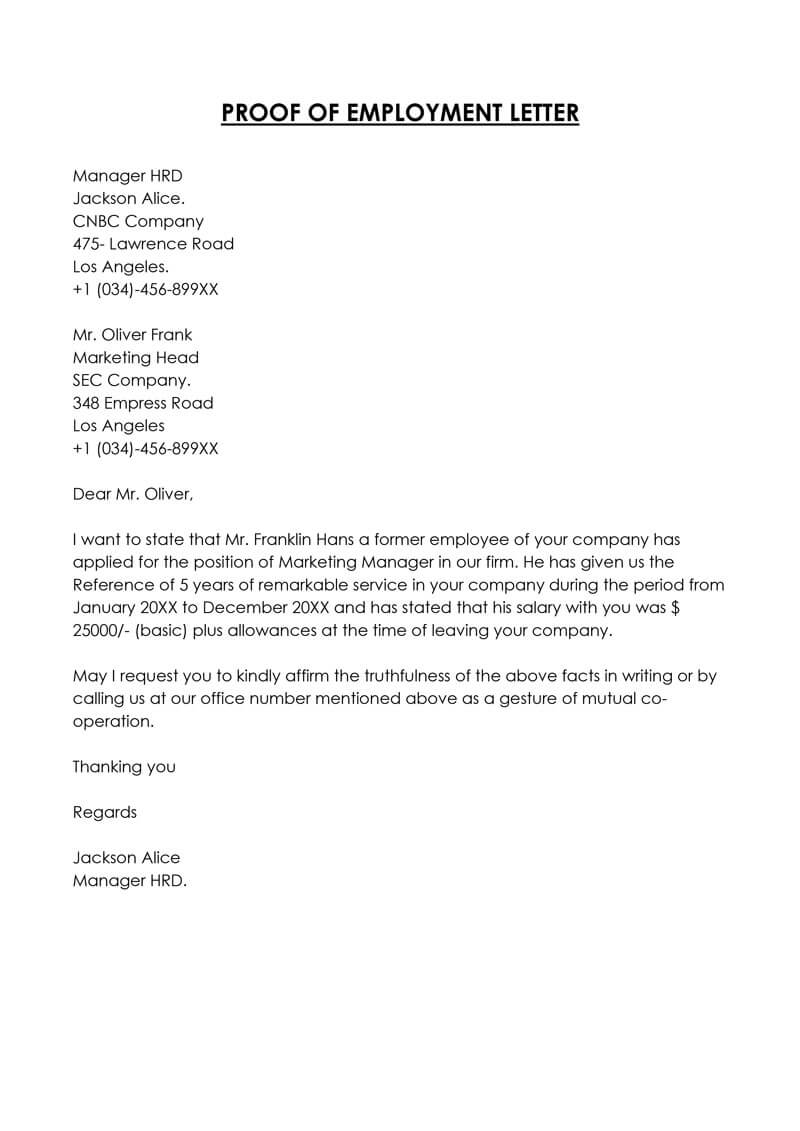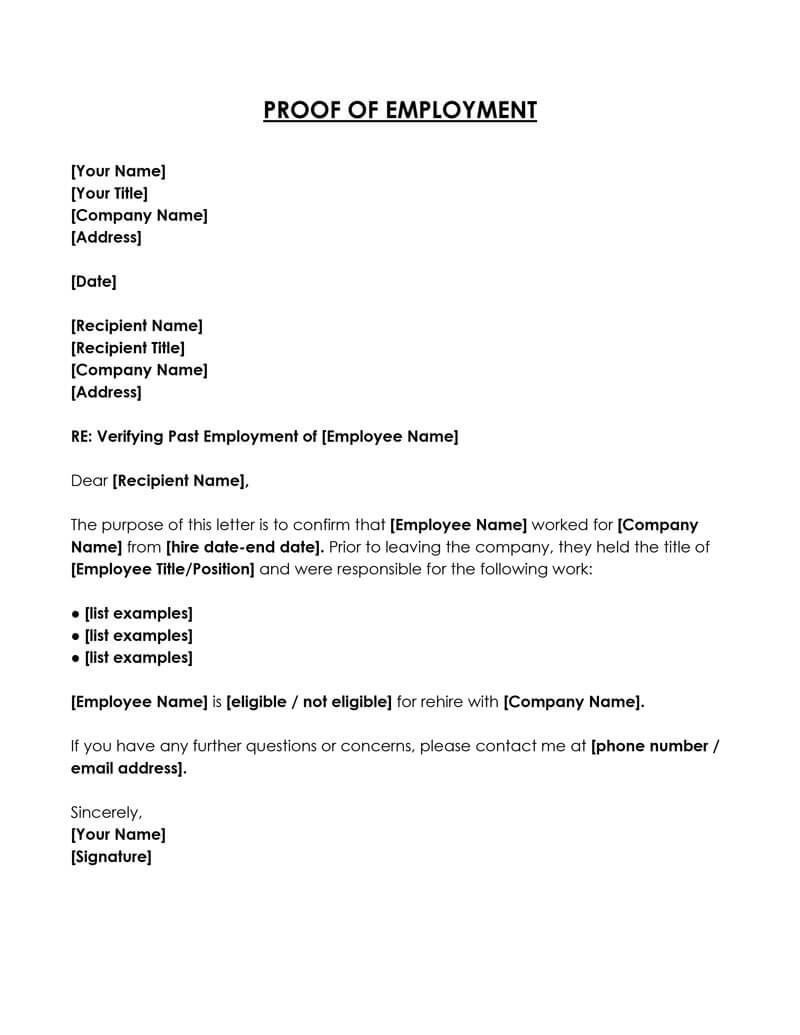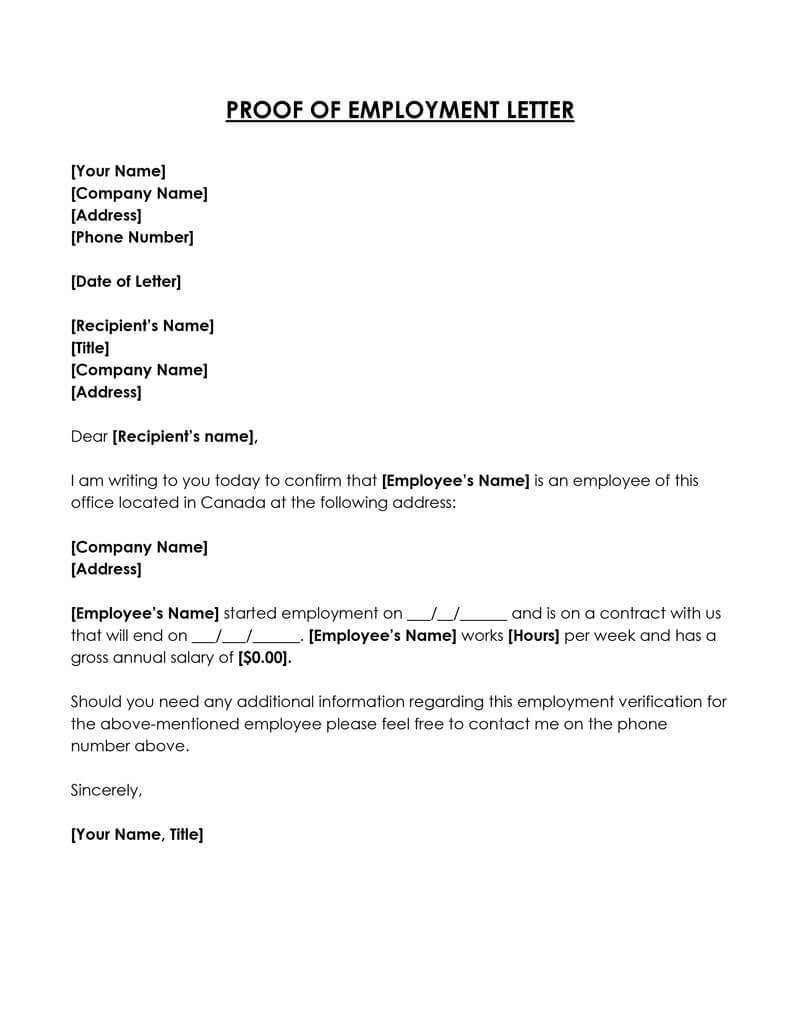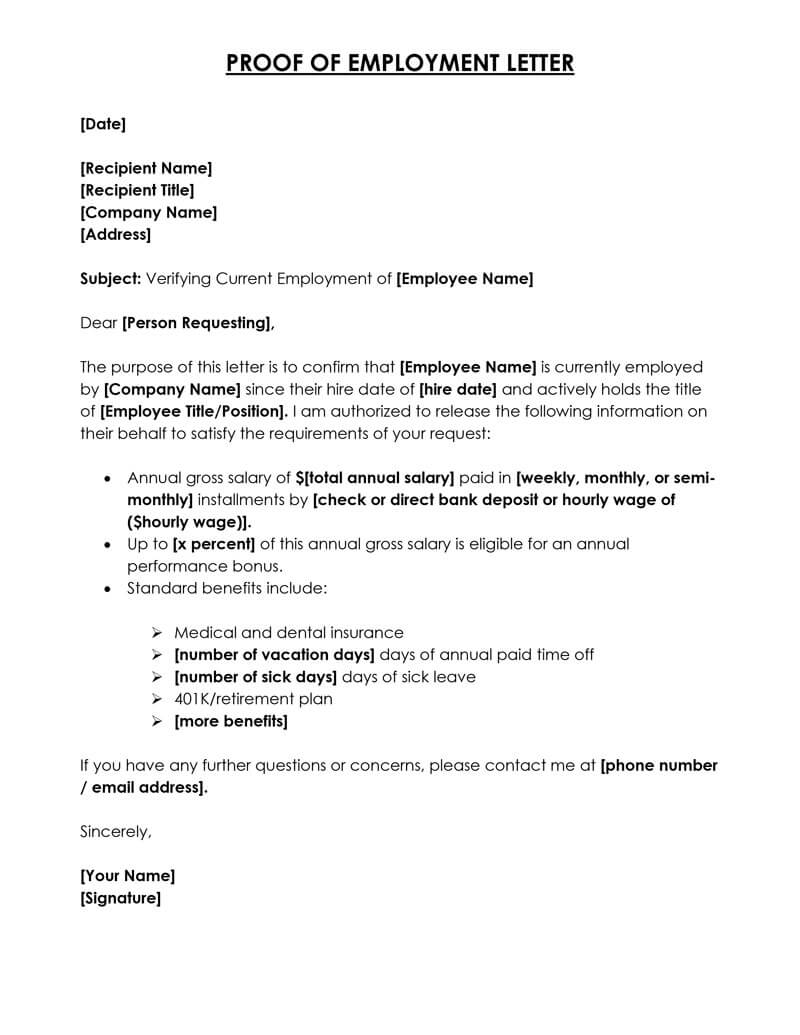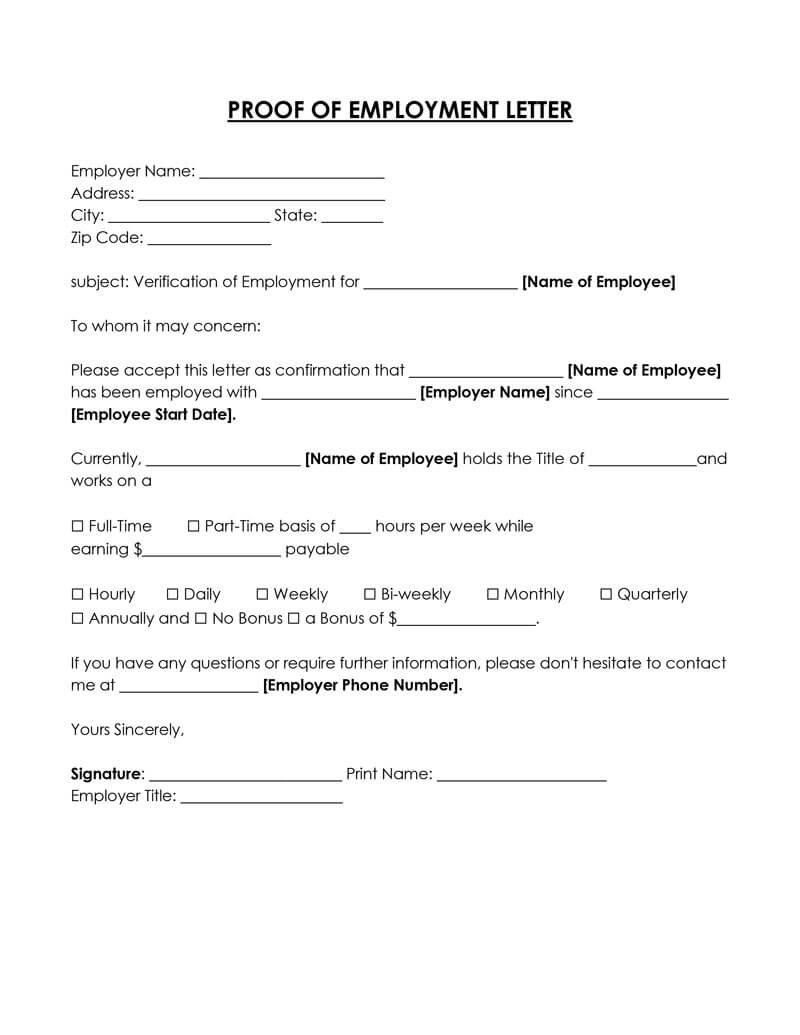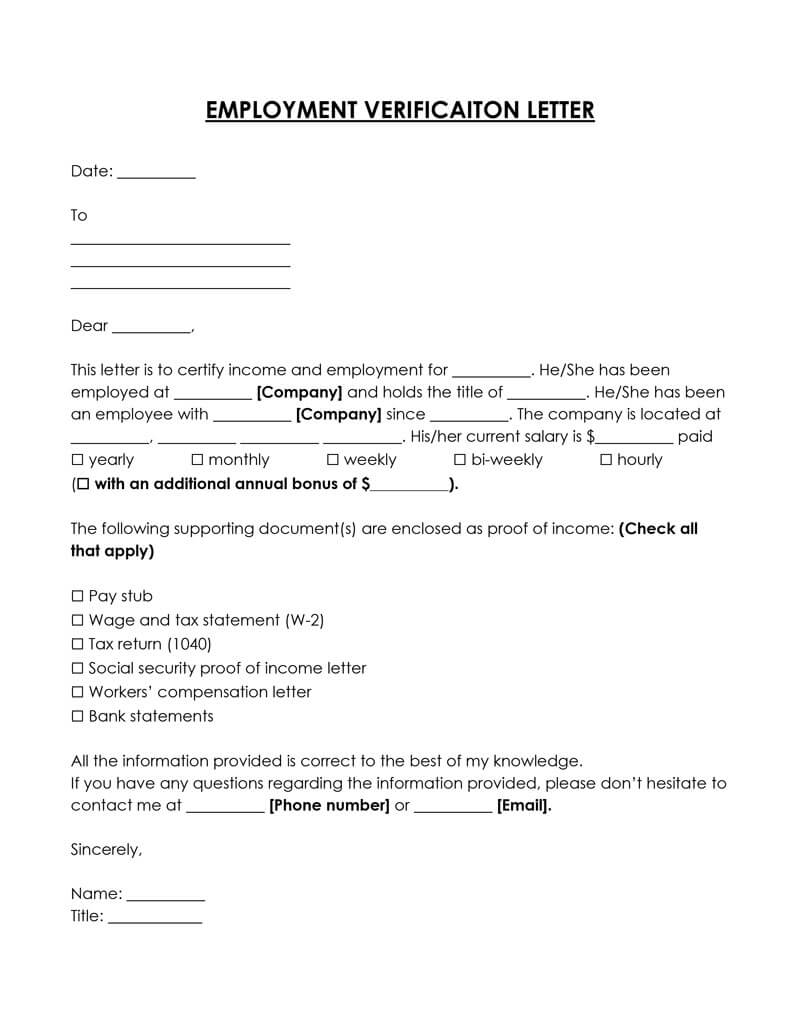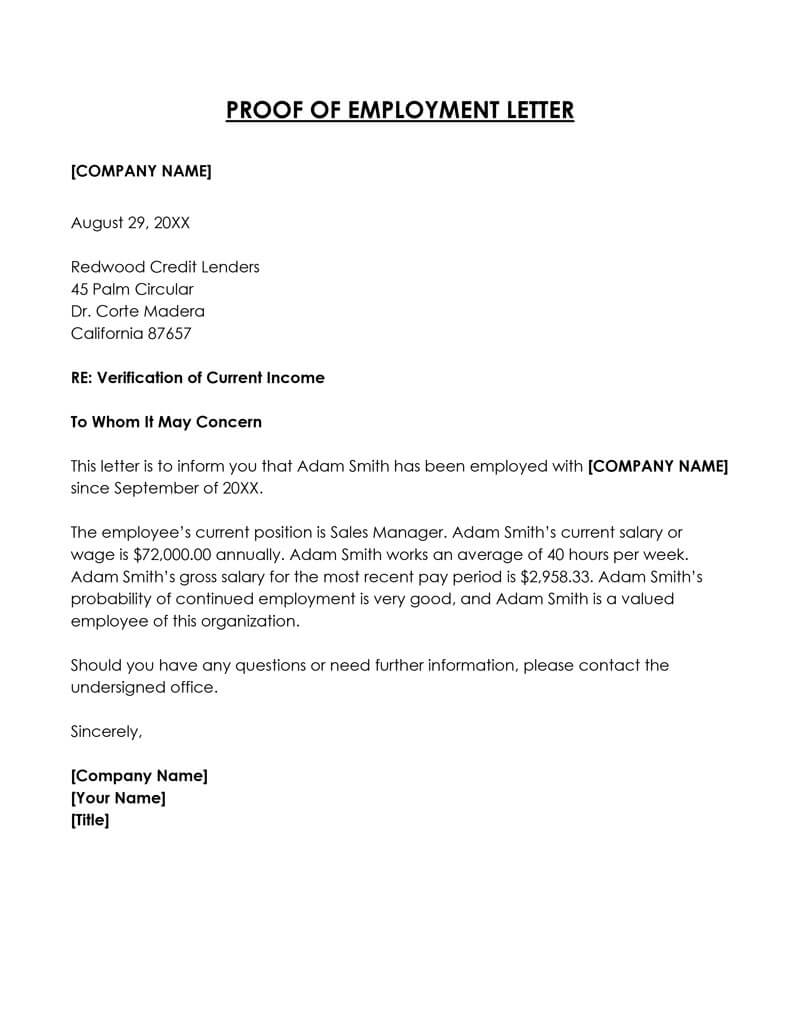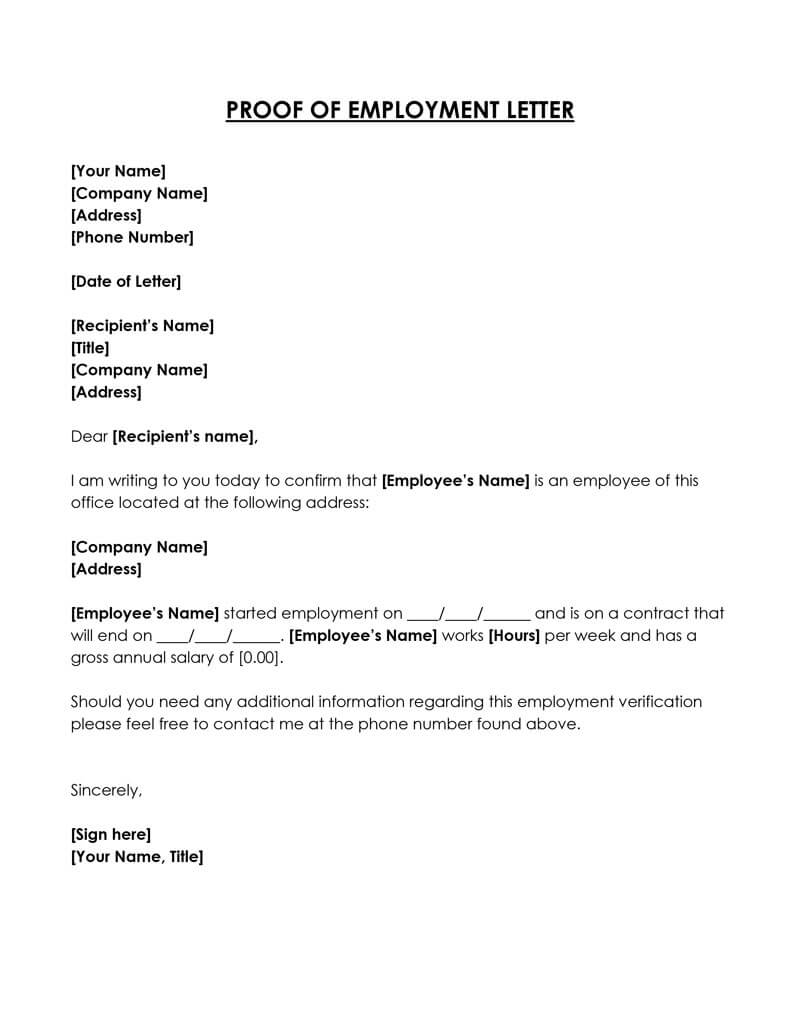If you work as a human resource officer at a company or manage a significant number of employees, you have probably been requested to provide a document proving that an employee is working for your company. This document is called a proof of employment letter. It is used to verify information about your employees, such as the duration of their employment and other details as may be requested by the third party. You must consider the requests from other companies, as your organization may restrict what information you can share with third parties.
This article discusses what proof of employment letter is. It also gives information on when you should write the letter instead of other methods of proof, including a credit report. In addition, it discusses how to write a letter and provides samples and templates you can use to write your letter.
Proof of Employment Letter Template
You may get many requests to provide this verification letter. However, since they are time-bound, you may find it difficult to prepare all of them from scratch. To ease this process, you should use templates. They provide a basic outline of the information you need to include. Then, all you have to do is edit the template to suit your needs. We provide free downloadable and editable proof of employment letter templates.
What is Proof of Employment Letter?
Proof of employment is a document confirming that an employee works or formerly worked for a company.
You, as the employer, write it on the employee’s behalf and at a third party’s request. Most companies have procedures and rules to be followed when issuing these letters. For example, some information, such as an employee’s health records, cannot be divulged to parties without the employee’s consent. These third parties that may make a request include banks, landlords, prospective employers, mortgage lenders, and collection and government agencies.
Different names can refer to the proof of employment letter, sometimes based on why proof of employment is needed.
Some of these alternative names include:
- Income verification letters
- Work verification letter
- Salary verification letter
- Proof of income letter
- Letter of employment
Besides an employment letter, other documents are used to verify an employee’s employment. However, unlike an employment letter, each document focuses on a specific aspect of an employee’s employment.
They include:
Past pay stubs
Pay stubs indicate the income an employee earned from their job. For reference, you should provide two or more pay stubs. Besides income, they also provide information on an employee’s taxes and investments, indicating their financial habits.
Past two years of tax returns
Tax returns show the employee’s annual income against their income tax calculations. In the United States, every citizen and resident is liable to pay taxes to the federal government. The forms filled in to file tax returns for employed candidates are a W-2, a wage, and a tax statement. Unemployed candidates use IRS Form 1040 to file their tax returns. The requester may also require the employer to provide Form 4506-T, a tax return for the previous calendar year.
Credit report
A credit report shows the employee’s debt and repayment. They help to establish an employee’s spending habits by assessing their credit card debts and mortgage. It is performed as a background check to help the requester decide whether to issue the employee with a credit card or a mortgage.
References
References are drawn from the employee’s previous colleagues. They include people that can attest to the employee’s character in a professional capacity. The employee should inform the referrer that they may receive a request from a third party to write a character reference letter on their behalf. This prior notice allows the referrer to prepare for the information they will provide to the third party.
Contract and other signed documents
You may use contracts and other documents as proof of employment. These contracts and documents should be originals or copies of originals signed by you. If you choose to use these documents, you should provide a cover page containing vital information like the name of the employee, the date they were employed, their salary, and the status of their employment. This cover page is preferred for complex and large contracts.
Bank statements
The employee’s bank statements can help the requester understand the employee’s spending habits by checking the income and outflow of the money.
A worker’s compensation letter
A compensation letter demonstrates benefits or compensation terms for the employee to review. It is often used as proof of employment to show that the employee works at the employer’s organization and that they are receiving particular payments due to a workplace injury. In addition, you can use this letter to show a lender that your employee can repay their loans.
Social security proof of income
The social security proof of income letter proves that your employee has supplementary income from social security benefits and medical coverage. Your employee can use this letter as proof of additional income or benefits from Medicare.
Why are Employment Verification Letters Written?
Verification letters help the requester confirm whether the employee will likely honour their financial obligations, such as paying rent or repaying a loan. Since requests for these letters must be responded to in time, you should set aside sufficient time to answer them and provide the requested information.
Some of the reasons why these letters are written include:
- Lenders may request a verification letter before providing a loan. For example, they can request the employee’s income information to confirm the amount they can lend to the employee. The information they get can also help them calculate repayment terms.
- Credit card companies often require a verification letter as proof of income. The employee’s income and other factors, such as credit score, may determine the maximum amount they can use on their card.
- Most landlords like to ensure tenants can pay their rent and other monthly bills. These letters provide income information to prove that the employee can pay rent. They can also determine property usage by assessing the employee’s work hours.
- When assessing an applicant, prospective hiring managers often confirm whether the employee was working for the company to verify the details provided in their resume or cover letter. Such information can be sued to make a hiring decision.
- Employees working on work visa status often have to verify to government agencies that they are employed in foreign countries; the verification letter confirms their employment status and positions in their companies.
How to Write Proof of Employment Letter? 5 Easy Steps
The proof of employment letter must provide complete and accurate information. Since it will affect the employee’s life, financial status, or even living status, the information provided must be factual.
The following steps can help you write a comprehensive letter:
Add your (employer) information
Your information includes the company name, position, address, city, state, and zip code. The third party can use this information to verify your company’s authenticity. This verification is critical to lenders that check for fraudulent activity before issuing loans.
For example:
Joseph Warwick
Human Resource Director, Treaty Inc.
4578 Kent Dr.
5878 New England, NE.
Specify name and address of the company requesting verification
Most requesters provide their contact details in the requester’s document; these details, along with the requester’s name and address, should be included in the letter. However, where you do not know the requester’s name or address, you may address it as “to whom it may concern.”
For example:
Janice Pearson,
Recruiter, Halliwell Property Management Inc.
0233 Riverson Dr
47580 Portland, OR
Indicate the date
It is crucial to state the date on which the letter was written. It allows the requester to keep a record and acts as evidence that it was sent within the deadline if there was one.
For example:
May 15, 2020.
Indicate employee’s details
The employee details section is a crucial part of the letter. It holds the information requested by the third party. All the information provided in this section must be accurate.
It includes:
Name
This is the name of the employee whose information you have been requested to provide. The name should be as it appears in the official company documents.
For example:
This letter is to verify that Dennis Pritt is an employee of Treaty Inc.
Employment start date
The employment start date should be mentioned in the employee’s contract. You can verify this information by looking at the employee’s contract for the exact date.
For example:
Dennis has been an employee since January 12, 2015.
Employee job title
Once you specify their employment date, you should state the employee’s position. If the employee has been promoted, you should state their most recent position.
For example:
He has held the position of Senior Software Engineer at Treaty Inc.
Employee job description
The job description should include a summary of the employee’s responsibilities per their job title. It would be best to list the primary duties to ensure the letter is brief.
For example:
He performed the following duties:
–Designed company distribution software
–Supervised existing software
–Reviewed project deadlines
–Testing and troubleshooting of software defects
Employee current salary
The employee salary should be stated as it allows the requester to decide whether they can accommodate the employee’s employment needs. Most employers indicate the annual salary, but you can also mention their monthly or hourly pay if the employee is not salaried.
For example:
Dennis received an annual salary of $150,550; I have included pay stubs for the past 12 months as proof of this amount.
Annual bonus amount
You should indicate whether the employee earns an annual bonus in addition to their annual salary. This amount should be exclusive of taxes.
For example:
Dennis’ annual bonus for the last year amounts to $15,055; this amount is 10% of his annual salary.
Employment end date
If the employee is no longer employed, you should mention the day they were terminated. This data could help the requester clarify some details. For example, indicating the employment end date could help the requester understand if the employee needed to issue a notice. Moreover, this also represents how long this notice period was issued before the employee could be free to join the third party’s organization.
For example:
His employment was terminated on amicable terms because of the lapse of his contract.
State the reason(s) for termination, if any
The reason for termination is essential to potential employers as it allows them to assess the employee’s character. Additionally, this consideration is significant for requesters doing a background check as they will consider it along with a criminal and credit score check where necessary.
For example:
Dennis notified us of his intention not to renew his contract with us as he had found a new position in another state. The notice was duly filed.
Add your signatures
Once you complete the letter, you should sign it to verify your identity as the writer. In addition, it makes the document more authentic.
For example:
Sincerely,
[Signature]
Joseph Warwick.
Note: You may create a section where the document will be notarized; however, this is optional.
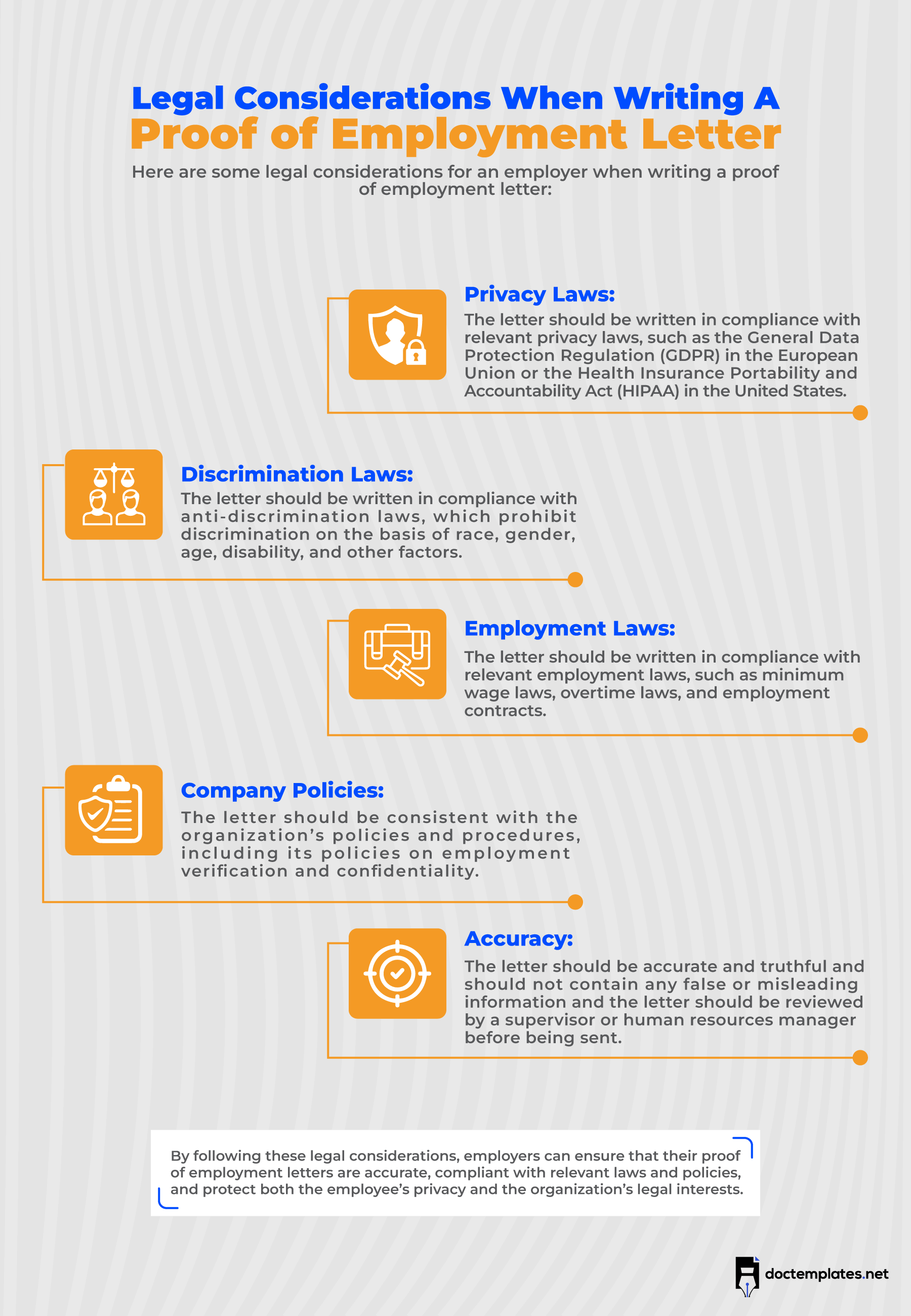
Proof of Employment Letter Template
[Employer’s name]
[Position, company name]
[Address]
[City, state zip code]
[Date]
[Requester’s name]
[Position, company name]
[Address]
[City, state zip code]
Dear [Requester’s name],
Please receive this letter as confirmation that [employee’s name] has been employed by [company name] since [employment start date]. She has been a [position/ title] earning an annual salary of $XXX.
Should you require further information on her employment, do not hesitate to get in touch with me at [phone number, email]
Sincerely,
[Signature]
[Employer’s name]
Proof of Employment Letter Sample
Holly Well,
Human Resource Manager, Princecorp Ltd.
1234 Arbor St.
5975 St. Nicks, TX
August 12, 2019
Christina Wellington,
Property Manager, Houston Properties Ltd.
6587 Magee Rd.
7342 Houston, TX
Dear Ms. Wellington,
This letter is to verify that Santana Collins is an employee of Princecorp Ltd. She has been an Associate Producer since January 22, 2017. Her annual salary is $123 450. I have attached her previous pay stubs and tax return forms as proof of the same.
If you require any clarifications regarding Santana’s employment, please get in touch with me at 2456 4754, [email protected].
Sincerely,
Holly Wells.
Do’s and Don’ts of Employment Verification Letter
Now that you know how to prepare your verification letter, you should consider a few tips on what you should and should not do when writing your letter.
Do’s
Your letter is official communication; it may be kept in the employee’s file. As such, it should be well-written. You can use the tips below to help you write an excellent employment verification letter:
- Follow the business letter format: The business letter format is standard; almost any requester can accept it. The format is convenient because it allows you to provide crucial information in a clear format. It should begin with the sender’s and recipient’s addresses, then a salutation. Finally, you should conclude your letter with a handwritten signature.
- Keep it short: You should limit the information you provide in your letter by using more straightforward and official language. For example, the recommended length for a verification letter is one page unless the information sought will reasonably exceed one page.
- Include all the relevant information: You should only provide relevant information to the requester. You may omit some personal details, especially if they violate the employee’s privacy. Where you mention pay stubs or tax returns, ensure you attach the relevant documents to the letter as you send it.
- Provide your contact information: Contact information allows the requester to reach you should they require further information about the employee. Most people prefer contacting others through phone or email; these two are the most convenient methods.
- Edit and proofread: Once you finish writing your letter, proofread it to check for grammar and spelling mistakes. You should also check the overall tone and language of the letter and ensure it sounds formal. You could also request someone else to check it to identify the mistakes you may not have seen.
- Get the consent of the employee: You should inform the employee that you have been requested by a third party to provide particular information about them. If the information you are required to provide is outside your scope of authorization, you should get the employee’s consent before writing the letter.
Other practices you should consider are discussed as follows:
- You should consult your human resources and legal department on whether there is an existing file for a former employee and how much of this former employee’s information you can release.
- The letter should be typed and not handwritten
- It would be best to use a formal salutation when writing your letter.
- The information you provide should be restricted to only what the requester has asked.
Don’ts
While you may have access to employee records, some acts are not allowed and, at times, illegal when writing your letter.
They include:
- You should avoid providing private information on an employee’s health status without their knowledge or consent.
- You should avoid providing more information than requested.
- You should not provide information that discriminates against an employee’s race, sex, gender, or religious beliefs.
- It is advisable to avoid giving personal opinions to the requester; instead, provide facts that you can verify.
Key Takeaways
- An employment verification letter is a formal communication from an employer to a requester confirming that an employee has worked or is working for them.
- The letter is often requested by landlords, credit card issuers, lenders, and government agencies.
- It provides information on an employee’s employment status, salary, position, and responsibilities at their workplace.
- Since it is official communication, the information provided in it should be factual. For example, information such as salary may be proven with pay stubs.
- Where the letter requires you to disclose private information, you should seek the employee’s consent before writing the letter to avoid legal liability.
